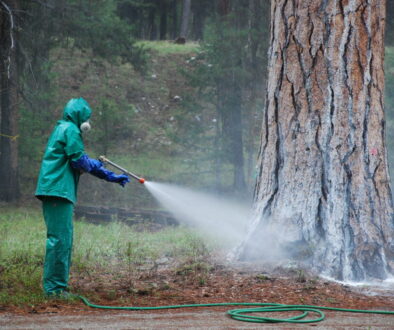Could farm fertilizers be driving Corn Belt cancers?
 BERNE, Minn. – It was a hot afternoon in mid-July and 60-year-old Brian Bennerotte was making a pilgrimage of sorts, navigating a shotgun-straight, gravel road south of Minneapolis on a journey through a landscape stitched with crop and livestock farms as far as the eye can see.
BERNE, Minn. – It was a hot afternoon in mid-July and 60-year-old Brian Bennerotte was making a pilgrimage of sorts, navigating a shotgun-straight, gravel road south of Minneapolis on a journey through a landscape stitched with crop and livestock farms as far as the eye can see.
Bennerotte is one of only three surviving members of a family who farmed for three generations along a mile-long stretch of County Road B. As a long-haul truck driver, Bennerotte rarely gets back here. But with a visitor at his side, he finds his way.
From the passenger seat of a rented vehicle he scans both sides of the road, then points to a dust-scoured barn leaning into the wind. The building is all that remains of his family’s farmstead, which once encompassed 200 acres and a home large enough for Bennerotte’s parents to raise five boys and a girl.
Down the road a bit further, he recognizes neighboring properties: There is the Glarner farm, and the Spreiter farm and the Serie farm. All are connected by circumstances of geography, topography, agriculture, and social commerce.
All are also joined by disease and death.
Among the four families who lived for decades along County Road B, 12 people developed cancer and seven died. Bennerotte was one of three people who developed lymphoma. The disease nearly killed him in 1983 when he was 20 years old. His father and three brothers would not survive their own bouts with cancer.
For some, County Road B has a different name: They call it Cancer Road.
“Every family along here was affected. Every one,” said Bennerotte.

Nitrate contamination
Though the causes of the cancers are not proven, suspicion centers on elevated levels of nitrates that have contaminated the drinking water for County Road B families. Just as they do throughout US farm country, nitrates commonly flow into well water and other water sources as runoff from fields treated with commercial fertilizer and livestock manure. Over the last decade, a growing number of peer-reviewed medical studies have linked exposure to nitrates in drinking water to elevated incidences of cancer.
Many of the County Road B cancers — breast, blood, colon, lymphoma — have been specifically associated in medical studies in the US and overseas with exposure to nitrates in drinking water.
Wells used by each of the families contained nitrate levels well above what authorities consider safe, according to Dodge County water monitoring data.
“It’s eyebrow raising that you have this cluster in this area where you have high levels of nitrates and kidney cancers and bladder and breast cancers,” said Paul Mathewson, science program director at the environmental advocacy group Clean Wisconsin. He acknowledged that it is often difficult to pinpoint specific causes for specific cancers, but said the County Road B cases show a strong link. “Those are some of the cancers that have been associated to increased risk with respect to nitrate contamination,” he said.
Mathewson is the lead author of a 2020 peer-reviewed study that identified nitrate contamination in drinking water as the probable cause of nearly 300 cases a year of colorectal and other cancers in Wisconsin.
The concerns have broad implications for all of US farm country. The US Geological Survey has found that 22% of private wells in rural areas exceed the 10 parts per million (ppm) safety limit for nitrates.
In Minnesota alone, authorities in 2017 found elevated levels of nitrates in 80 public water systems. In Iowa, 55,000 drinking water wells were contaminated with elevated nitrate concentrations, according to 2017 data. Private water wells serve about one-third of Wisconsin families and last year state authorities found 10% of them exceed the 10 ppm nitrate safety limit.
And in Nebraska, the US Environmental Protection Agency (EPA) reported in 2018 that groundwater beneath almost a fifth of Nebraska, over 13,000 square miles, is contaminated with nitrates at more than 5 ppm, the concentration many scientists now consider as the baseline level for causing health concerns.
Water quality data analyzed by the Environmental Working Group, a Washington-based research and advocacy group, found in 2020 that one in four residents of Illinois, Iowa, Kansas, Nebraska, and Wisconsin — 6.9 million people — were drinking nitrate-contaminated water from community water systems.
The cancer connection
Nitrogen is considered a necessity by most US corn growers, who see the fertilizer as a key tool for boosting yields and harvesting bumper crops. But commercial nitrogen fertilizer and nitrogen-rich livestock and poultry manure are the leading sources of the nitrate contaminants – formed when nitrogen combines with oxygen – that drain into surface and groundwater, according to state environment and agriculture agencies.
The amount of nitrogen applied to corn has increased 120 million pounds annually since 2000, according to the US Department of Agriculture (USDA). And the amount of nitrogen-rich and untreated liquid and solid manure from livestock being spread on farmland – most of it in the Midwest – grew to 1.4 billion tons by 2018, 300 million more tons than in 2007, USDA data shows. As much as 70% of the nitrogen applied to farmland, according to many studies, leaked off fields and drained as toxic nitrates into the region’s waters.
Exposures to nitrates in drinking water have long been known to pose a serious threat to infants because the presence of nitrates inhibits the ability of blood to carry oxygen. In 1962, US health authorities set 10 parts per million as the safe limit for nitrates in drinking water for preventing “blue baby syndrome.”
The science tying nitrates to cancer has been building over the last 20 years and continues to build. The Centers for Disease Control and Prevention says that when nitrates are ingested, they react with proteins and enzymes to form a group of chemicals called N-nitroso compounds, “which are known to cause cancer in animals and may cause cancer in humans.”
In 2001, researchers at the University of Iowa evaluated data from a long-term study of more than 20,000 women in Iowa and found increased risks of bladder and ovarian cancers associated with elevated nitrate levels in public drinking water supplies used by the women.
More recently, medical researchers have been conducting epidemiology studies, looking at large groups of people and what they’re exposed to and their rates of cancers. The results, some scientists say, indicate that exposure to nitrates in drinking water poses a health threat at much lower concentrations than the 10 ppm federal drinking water standard.
A 2018 peer-reviewed paper by National Cancer Institute researchers and other scientists evaluated 30 epidemiology studies of low-level exposure to nitrates in public drinking water systems, finding that many studies “observed increased risk with ingestion of water nitrate levels that were below regulatory limits.”
While noting that the number of studies “are still too few to allow firm conclusions about risk,” the researchers reported that the “strongest evidence for a relationship between drinking water nitrate ingestion and adverse health outcomes… is for colorectal cancer, thyroid disease, and neural tube defects. “
In 2019 the Environmental Working Group published a peer-reviewed study that found that exposure to nitrate in drinking water was causing over 12,000 cancer cases annually in the US.
“In the past decade or so there’s been a lot of new research making a strong, compelling case that even at nitrate levels that are much lower than 10 parts per million you’re seeing these increased risks,” said Mathewson. “There needs to be greater awareness. The science is out there.”
That view is not entirely universal. The Fertilizer Institute, the trade organization for the $27 billion US commercial fertilizer industry, issued this statement in 2017: “The US Agency for Toxic Substances and Disease Registry does not characterize nitrate as a carcinogen,” and added that the EPA expressly notes “conflicting results across studies, and design limitations in a number of epidemiological studies that have investigated associations between nitrate or nitrite exposure and cancer.”
Corn belt cancers
Adding to the evidence is data showing that rates of cancer in some Corn Belt states are higher than the overall US incidence rates for cancer. Of the 15 states with the highest cancer incidence, Iowa, the nation’s top corn-growing state, ranked second, led only by Kentucky. Four other farm belt states — Minnesota, Wisconsin, North Dakota, and South Dakota — are in the top 15, according to the data from the Centers for Disease Control.
“I was definitely surprised by that,” said Mary Charlton, professor of epidemiology at the University of Iowa and director of the Iowa Cancer Registry. “I don’t think anybody thought of ourselves as being a very high cancer state.”
As science builds tying nitrates to cancers, children’s health is a key concern. Pediatric cancer is now more common in Nebraska than anywhere west of the Mississippi River, according to researchers at the University of Nebraska Medical Center.
The cases are associated with Nebraska watersheds that have high levels of nitrate or atrazine — a weed killer — in surface and groundwater. In Aurora, Nebraska, one particularly hard-hit town, seven children were diagnosed with cancer from 2005 to 2013. Five died.
“Our incidence of pediatric cancer is significantly higher than the surrounding states,” said Eleanor Rogan, chair of the university’s Department of Environmental, Agricultural, and Occupational Health. “We’ve mapped the three most prevalent types of pediatric cancer in Nebraska and they are central nervous system cancers and brain tumors, that are really driving this high incidence.”
A tragic toll
Along Minnesota’s County Road B, the list of area residents struck by cancer is long.
On one farm, Irene Spreiter developed breast cancer, and her son, Darren, was diagnosed with Hodgkin’s lymphoma, a cancer of the lymph system, when he was 11. Christine Hachfeld moved onto the farm as well, only to then develop multiple myeloma.
Down the road from the Spreiter farm, neighbor Audrey Serie died of cancer in 2021. Neighbor Bonnie Glarner also died in 2021 after developing breast cancer in the mid-1970s at age 35. Glarner’s son, Scott Glarner, developed non-Hodgkin lymphoma in 2005 at the age of 43 but survived and moved away from County Road B.
“People talked about it,” said Glarner, who works as postmaster. “People questioning, what’s up with the water? Because of all the cancer that people had up and down that road.”
More than any other County Road B family, cancer wrecked the Bennerotte family, taking the lives of patriarch Howard Bennerotte and three of his five sons. A daughter and fourth son developed cancer but have survived.
Howard farmed on County Road B until dying of kidney cancer in 1983 at the age of 64. Son Chuck Bennerotte became the principal farm manager following the death of his father but died of bone cancer in 2000 at age 57. Chuck’s wife, Joanne, also developed bone cancer and died in 2015.
Another son, Gary, developed colon cancer that led to his death in 2006 at age 65, while Wesley, the youngest brother of the clan, developed leukemia, a blood cancer, and died in 2019 when he was 67.
The family’s lone daughter, Myrna, also developed cancer, but has so far survived it and is living in Michigan.
Stuart Bennerotte, like his brother Brian, so far is also a cancer survivor. He developed a benign tumor on his pancreas in 2003 when he was 57, and later was diagnosed with prostate cancer for which he is undergoing treatment.
Dodge County officials conducted nitrate monitoring for the drinking water wells used by those County Road B families from 1990 through 2015, finding that nitrate levels in the Glarner family well consistently tested at 11 ppm from 2002 to 2011. The highest nitrate concentrations, 25 ppm, were found in 2001 in the Spreiters’ well. Nitrate concentrations in the Bennerottes’ well were 8 ppm in 1990 and 7.1 ppm in 2013.
When Brian Bennerotte’s tumor was discovered in the early 1980s, it was wrapped around his heart and other vital organs. Doctors at the Mayo Clinic in Rochester, 40 miles away, saved his life by exposing the tumor to massive doses of radiation, but warned Bennerotte that his heart and lungs would sustain permanent damage that would affect the rest of life. He’s been in and out of hospitals ever since for heart surgery and other urgent health issues.
“The doctors told me they had to save my life,” he said. “I live with it. My father. My brothers. They didn’t.”
(This report, co-published with Circle of Blue, was made possible by an investigative reporting fellowship awarded by the Alicia Patterson Foundation and the Fund for Investigative Journalism. It is part of an ongoing series looking at how changing agricultural policies are affecting human and environmental health.)
(Keith Schneider, a former New York Times national correspondent, is senior editor for Circle of Blue. He has reported on the contest for energy, food, and water in the era of climate change from six continents. )
 EWG
EWG



September 18, 2023 @ 7:33 am
Why is the headline a question even?
This is ALL subsidized by the US GOV with make-believe debt-based funny money!
Privatize the gains and socialize the losses.
Is this a great system or what! said the grain merchant!
My gobmint is a criminal enterprise!!